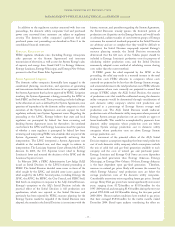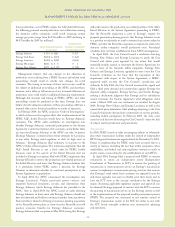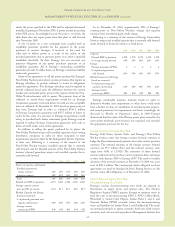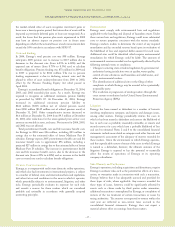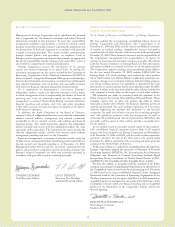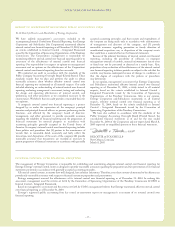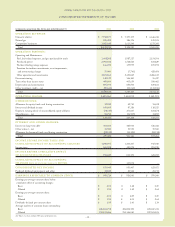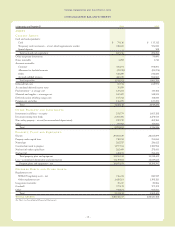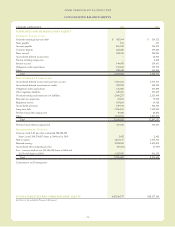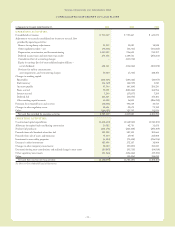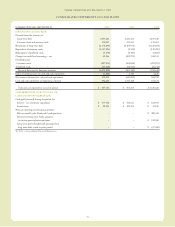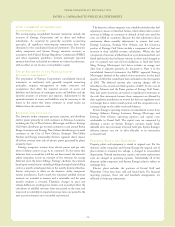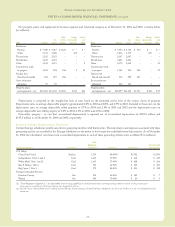Entergy 2004 Annual Report Download - page 47
Download and view the complete annual report
Please find page 47 of the 2004 Entergy annual report below. You can navigate through the pages in the report by either clicking on the pages listed below, or by using the keyword search tool below to find specific information within the annual report.
Entergy Corporation and Subsidiaries 2004
the market-related value of assets recognizes investment gains or
losses over a twenty-quarter period, the future value of assets will be
impacted as previously deferred gains or losses are recognized. As a
result, the losses that the pension plan assets experienced in 2002
may have an adverse impact on pension cost in future years
depending on whether the actuarial losses at each measurement date
exceed the 10% corridor in accordance with SFAS 87.
Costs and Funding
In 2004, Entergy’s total pension cost was $98 million. Entergy
anticipates 2005 pension cost to increase to $117 million due to
decreases in the discount rate (from 6.25% to 6.00%) and the
expected rate of return (from 8.75% to 8.5%) used to calculate
benefit obligations. Pension funding was $73 million for 2004 and
in 2005 is projected to be $186 million. The rise in pension
funding requirements is due to declining interest rates and the
phased-in effect of asset underperformance from 2000 to 2002,
offset by the Pension Funding Equity Act relief passed in
April 2004.
Entergy’s accumulated benefit obligation at December 31, 2004,
2003, and 2002 exceeded plan assets. As a result, Entergy was
required to recognizean additional minimum pension liability
as prescribed by SFAS 87. At December 31, 2004, Entergy
increased its additional minimum pension liability to
$244 million ($218 million net of related pension assets)
from $180 million ($149 million net of related pension assets) at
December 31, 2003. Other comprehensive income decreased to
$6.6 million at December 31, 2004 from $9.3 million at December
31, 2003, after reductions for the unrecognized prior service cost,
amounts recoverable in rates, and taxes. Net income for 2004, 2003,
and 2002 was not affected.
Total postretirement health care and life insurance benefit costs
for Entergy in 2004 were $86 million, including $23 million in
savings due to the estimated effect of future Medicare Part D
subsidies. Entergy expects 2005 postretirement health care and life
insurance benefit costs to approximate $96 million, including a
projected $27 million in savings due to the estimated effect of future
Medicare Part D subsidies. The increase in postretirement health
careand lifeinsurance benefit costs is due to the decrease in the
discount rate (from 6.25% to 6.00%) and an increase in the health
care cost trend rate used to calculate benefit obligations.
Other Contingencies
Entergy, as a company with multi-state domestic utility operations,
and which also had investments in international projects, is subject
to a number of federal, state, and international laws and regulations
and other factors and conditions in the areas in which it operates,
whichpotentiallysubject it to environmental, litigation, and other
risks. Entergy periodically evaluates its exposure for such risks
and records a reserve for those matters which are considered
probable and estimable in accordance with generally accepted
accounting principles.
Environmental
Entergy must comply with environmental laws and regulations
applicable to the handling and disposal of hazardous waste. Under
these various laws and regulations, Entergy could incur substantial
costs to restore properties consistent with the various standards.
Entergy conducts studies to determine the extent of any required
remediation and has recorded reserves based upon its evaluation of
the likelihood of loss and expected dollar amount for each issue.
Additional sites could be identified which require environmental
remediation for which Entergy could be liable. The amounts of
environmental reserves recorded can be significantly affected by the
following external events or conditions:
•Changes to existing state or federal regulation by governmental
authorities having jurisdiction over air quality, water quality,
control of toxic substances and hazardous and solid wastes, and
other environmental matters.
•The identification of additional sites or the filing of other
complaints in which Entergy may be asserted to be a potentially
responsible party.
•The resolutionor progressionof existing matters through the
courtsystem or resolutionby the United States Environmental
Protection Agency (EPA).
Litigation
Entergy has been named as defendant in a number of lawsuits
involving employment, ratepayer, and injuries and damages issues,
among other matters. Entergyperiodically reviews the cases in
which it has been named as defendant and assesses the likelihood of
loss in each case as probable, reasonably estimable, or remote and
records reserves for cases which have a probable likelihood of loss
and can be estimated. Notes 2 and 8 to the consolidated financial
statements include moredetail on ratepayer and other lawsuits and
management’s assessment of the adequacy of reserves recorded for
these matters. Given the environment in which Entergy operates,
and the unpredictable nature of many of the cases in which Entergy
is named as a defendant, however, the ultimate outcome of the
litigation Entergy is exposed to has the potential to materially
affect the results of operations of Entergy, or its operating
company subsidiaries.
Sales Warranty and Tax Reserves
Entergy’s operations, including acquisitions and divestitures, require
Entergy to evaluate risks such as the potential tax effects of a trans-
action, or warranties made in connection with such a transaction.
Entergy believes that it has adequately assessed and provided for
these types of risks, where applicable. Any reserves recorded for
these types of issues, however, could be significantly affected by
events such as claims made by third parties under warranties,
additional transactions contemplated by Entergy, or completion of
reviews of the tax treatment of certain transactions or issues by
taxing authorities. Tax reserves not expected to reverse within the
next year are reflected as non-current taxes accrued in the
consolidated financial statements. Entergydoes not expect a
material adverse effect on earnings from these matters.
-45 -
MANAGEMENT’S FINANCIAL DISCUSSION and ANALYSIS concluded


